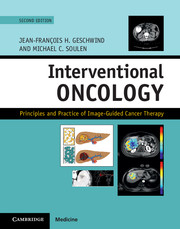Book contents
- Frontmatter
- Contents
- List of contributors
- Section I Principles of oncology
- Section II Principles of image-guided therapies
- Section III Organ-specific cancers – primary liver cancers
- 10 Assessment and triage of hepatocellular carcinoma
- 11 Image-guided ablation of hepatocellular carcinoma
- 12 Embolization of liver tumors: Anatomy
- 13 Conventional chemoembolization and chemoembolization with drug-eluting beads: Technique and future potential
- 14 90Yttrium radioembolization for hepatocellular carcinoma
- 15 Image-guided therapy of intrahepatic cholangiocarcinoma
- Section IV Organ-specific cancers – liver metastases
- Section V Organ-specific cancers – extrahepatic biliary cancer
- Section VI Organ-specific cancers – renal cell carcinoma
- Section VII Organ-specific cancers – chest
- Section VIII Organ-specific cancers – musculoskeletal
- Section IX Organ-specific cancers – prostate
- Section X Specialized interventional techniques in cancer care
- Index
- References
14 - 90Yttrium radioembolization for hepatocellular carcinoma
from Section III - Organ-specific cancers – primary liver cancers
Published online by Cambridge University Press: 05 September 2016
- Frontmatter
- Contents
- List of contributors
- Section I Principles of oncology
- Section II Principles of image-guided therapies
- Section III Organ-specific cancers – primary liver cancers
- 10 Assessment and triage of hepatocellular carcinoma
- 11 Image-guided ablation of hepatocellular carcinoma
- 12 Embolization of liver tumors: Anatomy
- 13 Conventional chemoembolization and chemoembolization with drug-eluting beads: Technique and future potential
- 14 90Yttrium radioembolization for hepatocellular carcinoma
- 15 Image-guided therapy of intrahepatic cholangiocarcinoma
- Section IV Organ-specific cancers – liver metastases
- Section V Organ-specific cancers – extrahepatic biliary cancer
- Section VI Organ-specific cancers – renal cell carcinoma
- Section VII Organ-specific cancers – chest
- Section VIII Organ-specific cancers – musculoskeletal
- Section IX Organ-specific cancers – prostate
- Section X Specialized interventional techniques in cancer care
- Index
- References
Summary
Radioembolization refers to the intra-arterial, transcatheter administration of micrometer-sized particles loaded with a radioisotope, most commonly yttrium-90 (Y90). Because liver tumors derive the majority of their blood supply from hepatic arteries, as opposed to the predominantly portal venous blood supply of normal liver tissue, hepatic arterial injection of Y90-labeled microspheres results in greater deposition of the spheres in tumor tissue as opposed to normal liver parenchyma. Since Y90 radioembolization provides an internal source of radiation to hepatic tumors, it is considered brachytherapy.
Preferential deposition of radioactive microspheres within tumor tissue provides for relative sparing of the uninvolved liver parenchyma from the radiation effects of Y90, thereby permitting significantly higher radiation doses than can be safely administered using external-beam radiation. The radiosensitive nature of normal liver tissue has traditionally limited the role of external-beam radiation in the treatment of primary and metastatic hepatic malignancies, as the incidence of severe radiation-induced liver disease (RILD) may exceed 50% for external-beam radiation doses greater than 35–40 Gy. However, with radioembolization, radiation doses in excess of 150 Gy can be safely administered.
Y90, a pure beta emitter with a half-life of 64.2 hours and tissue penetration of 2.5–11 mm, is incorporated into glass or resin microspheres ranging in size from 20–30 μm (glass) to 20–60 μm (resin). Glass microspheres (Therasphere, BTG International Canada, Ottawa, ON, Canada) were approved in 1999 by the US Food and Drug Administration (FDA) under a Humanitarian Device Exemption for the treatment of unresectable hepatocellular carcinoma (HCC). Resin microspheres (SIR-Spheres, Sirtex Medical, Lane Cove, Australia) were granted full premarketing approval in 2002 by the US FDA for the treatment of unresectable colorectal metastases in conjunction with intrahepatic floxuridine.
Safe and effective treatment of hepatic tumors with radioembolization requires not only the angiographic and endovascular skills critical for selective embolization procedures, but also a comprehensive understanding of radiation administration and safety, including radiation dosimetry and radiation dose modification based on tumor characteristics and a patient's clinical profile.
Patient selection
The patient selection process for Y90 radioembolization involves an assessment of the patient's burden of disease, hepatic biochemical profile, and performance status. Patients should have no extrahepatic disease and a tumor burden less than 70% of the liver volume.
- Type
- Chapter
- Information
- Interventional OncologyPrinciples and Practice of Image-Guided Cancer Therapy, pp. 128 - 133Publisher: Cambridge University PressPrint publication year: 2016



